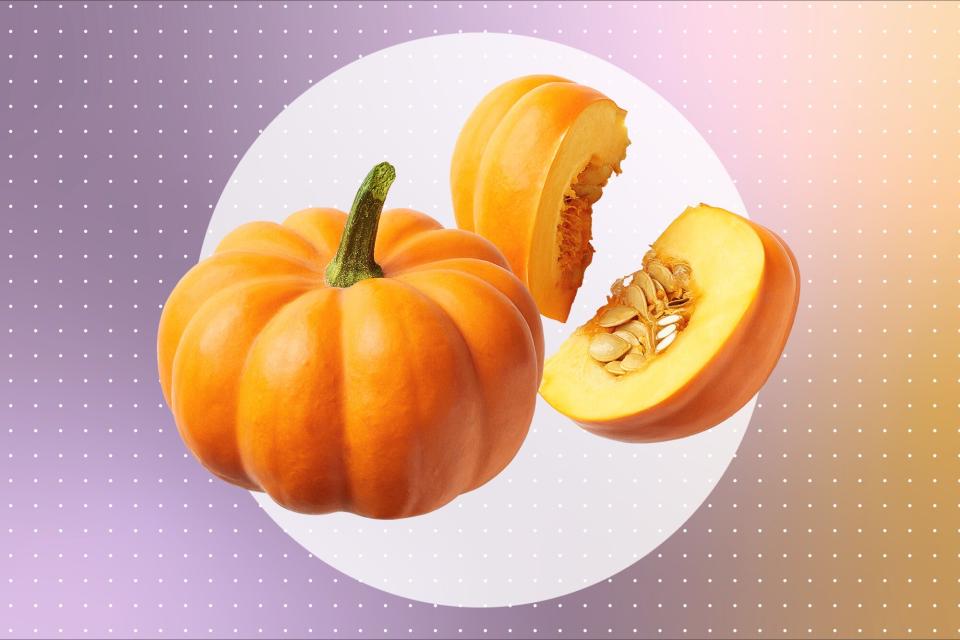What to Do with Leftover Pumpkin Guts

Getty Images
After carving a pumpkin for a jack-o'-lantern or using it in a delicious recipe, you're usually left with a mess. But don't transfer that mess to the trash just yet! You can actually turn those stringy pumpkin guts (aka pulp and seeds—here's how to separate them) into more things than you might think. Read on to learn more about their health benefits and what to do with leftover pumpkin guts.
Related: 10+ Easy Pumpkin Desserts
Health benefits
Not only is pumpkin festive for the fall, it has some amazing health benefits, too! Here are a few potential health benefits that you need to know about:
Boost your immunity: Pumpkin is high in vitamin A, which not only contributes to pumpkins' orange color but is a vital nutrient that helps boost immunity.
Destroy cancer cells: Like other orange fruits and vegetables, pumpkin is rich in carotenoids. Getting the carotenoid beta carotene from fruits and vegetables can help bolster your body's ability to destroy cancer cells.
Improve your eye health: In a study of over 100,000 individuals followed for 35 years, those who ate a higher-carotenoid diet lowered their risk of advanced macular degeneration (a leading cause of vision loss) by 25% to 35%.
But don't forget about the seeds! They have their fair share of health benefits as well:
Rich in antioxidants: Pumpkin seeds are full of antioxidants, which can protect your cells and reduce inflammation.
High in magnesium: Pumpkin seeds are a great source of magnesium, which helps your heart and bone health, as well as blood sugar levels and blood pressure. Magnesium also helps promote relaxation and deep sleep.
How to store pumpkin pulp & seeds
Pulp
After removing the seeds from the pulp, you can refrigerate the pulp in an airtight storage container for two to four days, until ready for use. Or, stick it in the freezer in a tightly sealed container, where it will last up to three months. You may puree the pulp first, if that fits your intended use. Defrost frozen pulp in the refrigerator overnight.
Seeds
Rinse the pumpkin seeds in a colander, strainer or the basket of a salad spinner, making sure to remove any stuck-on pulp. If using a salad spinner, take the seeds for a spin and then pour them onto paper or clothe towels and pat dry. Transfer the seeds to dry towels and let them sit out overnight. It's important the seeds are thoroughly dry to avoid mold growth. Refrigerate the dry seeds in an airtight container, and plan to use them within a week, or place them in the freezer alongside the pulp where they will last (at least) up to three months as well.
Related: Everything You Need To Know About Pumpkin Puree
What to do with leftover pumpkin pulp & seeds
Vegetable Stock
Homemade Vegetable Stock isn't as hard as you might think! All it requires is a little planning. Keep a gallon-size reusable bag in your freezer at all times, and add scraps of veggies as you cook. Once your bag is full of trimmings, scraps and pulp from onions, celery, carrots ... and pumpkin, add them to a pot, cover with water and set to simmer. Add any aromatics and spices you like, depending on the intended use of the stock. Not only are you reducing food waste, it's easy and delicious, too! Use it as the base for your next batch of your favorite soup.
Roasted Pumpkin Seeds
Don't forget about the seeds (and their health benefits)! Pumpkin seeds are extremely versatile and quick to roast. If you're in the mood for something sweet, try Cinnamon-Sugar Pumpkin Seeds. Looking for something savory? Try your hand at Pumpkin Seeds with Everything Bagel Seasoning made from scratch. You can also add them to granola bars, loose granola, and trail mixes for your next hike.
Once you have roasted seeds at the ready (you can store them in an airtight container in the fridge for at least a month), sprinkle them on salads or even nachos—anywhere that could use a tasty, nutty crunch.
Get Creative
Puree your pulp on its own and add it to canned pumpkin puree to boost flavor in pumpkin recipes like pumpkin bread. You may also add the puree directly to foods like oatmeal, rice and risotto, hummus and butter—for pumpkin butter. When adding your puree to foods that are raw or already cooked, cook the pureed pulp first by sautéing it until the color deepens, that raw taste is gone and the puree smells pleasantly of pumpkin. It should only take about five to 10 minutes.
If you're a pumpkin spice aficionado, you can sprinkle it into any of the above preparations (or when sautéing the pulp puree separately) to create that warm and cozy flavor profile that celebrates everything autumn.
For hummus, you can mix it into either your favorite brand or into your homemade hummus. But don't stop at hummus, you can add your pulp to a variety of dips and spreads like Skillet Sun-Dried Tomato Dip. Even plain ole cream cheese gets a little more exciting when you add your cooked puree with a hit of pumpkin spice.
Related: Healthy Pumpkin Seed Recipes
Bottom line
Don't just pile up pumpkin guts on some old newspaper, wrap it and toss it. There are so many uses for both the pulp and seeds. From soups to breads to crunchy snacks, when you use the whole pumpkin, you create less waste, get more bang for your buck and add to your repertoire of delicious, healthy dishes.

